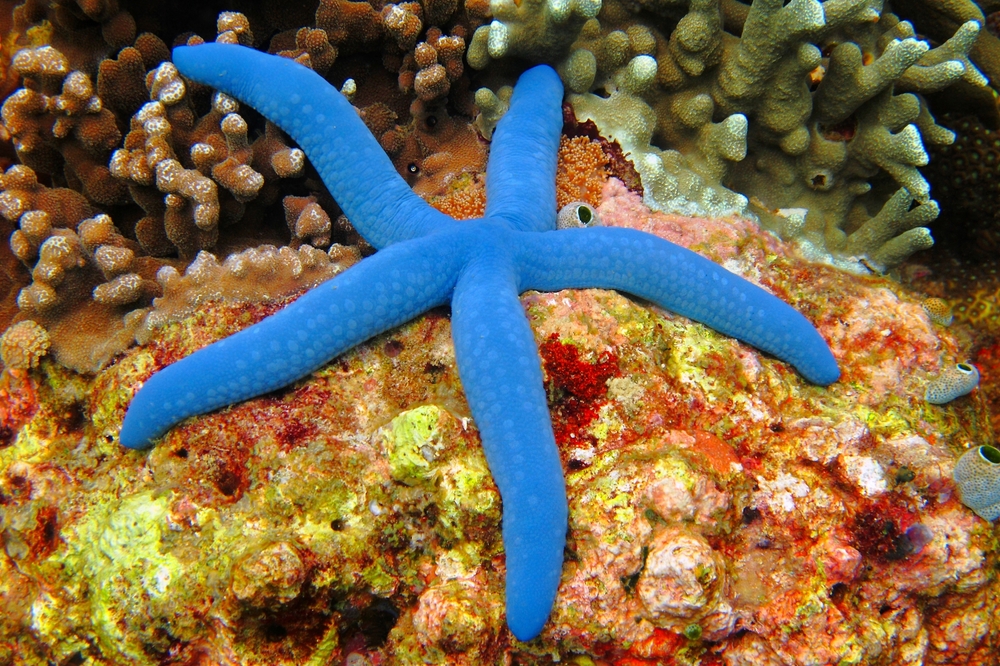Discover How Starfish Gained Five Arms After Evolving From 500-Million-Year-Old Ancestor


The five-armed figure of many starfish has to be one of the most iconic underwater curiosities in the world. How did these marine invertebrates attain such a bizarre body? It turns out that they weren’t always graced with plentiful limbs, but rather, gained them over time. About 500 million years ago, an ancestor of starfish only possessed two symmetrical arms.
A new study published in Current Biology explores the winding evolutionary road of starfish, revealing how they transformed into their stellar shape. Researchers recently discovered a 500-million-year-old fossil in Morocco and described it as a newfound species, Atlascystis acantha, which has established a starting point for all echinoderms (a group that includes starfish, sea cucumbers, and sea urchins).
Modern Starfish Symmetry
Modern starfish and other echinoderms display what is known as pentaradial symmetry, a rare body structure usually divided into five segments. This comes in the form of five arms for most starfish, although some species have even more — adult sunflower sea stars, for example, can have up to 24 arms.
The five-armed shape is in stark contrast to bilateral symmetry, which the majority of species on Earth — 99 percent — exhibit. Even starfish come from bilateral roots in more ways than one.
All echinoderms, including starfish, start their lives as bilaterally symmetrical larvae. As they develop into adults, they assume their distinctive pentaradial bodies. Their early bilateral stage, however, seems to have been sustained over hundreds of millions of years.
The original ancestor of echinoderms, Atlascystis acantha, likely showed bilateral symmetry throughout its whole life. Researchers involved with the new study examined a set of fossils unearthed in the Anti-Atlas mountains of Morocco and were able to ascertain the anatomy of the ancient species, which lived on seafloors during the Cambrian period.
Read More: How These 4 Animals Can Regenerate and Why Humans Can’t
The Ancestor of Starfish
The researchers found that Atlascystis had a flattened, spine-covered body with bilateral symmetry and a pair of skeletal plates that would have functioned like ambulacra, an area on the shell of modern echinoderms that the invertebrates use to move and feed.
Although the researchers don’t have concrete evidence of the larval stage for Atlascystis, they believe the species experienced a less drastic metamorphosis into adulthood than living echinoderms.
“So rather than completely reorganizing the anterior-posterior axis during their development, they probably retained the larval body axis into the adult form,” said co-lead author Imran Rahman, Principal Researcher at the Natural History Museum in the U.K., in a statement. “That meant they didn’t have to squish their internal organs, grow new openings, or twist the whole body around in the sorts of weird and wonderful ways we see in modern echinoderms.”
How Evolution Gave Starfish Five Arms
Using 3D imaging, growth analyses, and phylogenetic methods, the researchers determined that Atlascystis sits near the base of the echinoderm evolutionary tree.
Echinoderm evolution took quite the circuitous route from the bilateral symmetry of Atlascystis to the five or more arms of modern starfish. The researchers followed this path by tracking the changes in ambulacra throughout their evolutionary history, which didn’t exactly follow a straight line.
“So originally the echinoderms had two ambulacra,” said Rahman. “There is then a reduction to one, before what we think is a duplication event of that one remaining arm-like structure to give rise to three and then later to five ambulacra.”
Echinoderms eventually landed on five ambulacra, giving them their unique pentaradial form. However, the researchers still aren’t sure why starfish and their relatives developed this form as opposed to any other form. Though the origins of the familiar starfish shape now have an ancient foundation, it seems as though a complete answer to this mystery remains more than an arm’s length away.
Read More: Sea Cucumbers Could Be the Key to Stopping Cancer Growth With a Rare Sugar Compound
Article Sources
Our writers at Discovermagazine.com use peer-reviewed studies and high-quality sources for our articles, and our editors review for scientific accuracy and editorial standards. Review the sources used below for this article:
Jack Knudson is an assistant editor at Discover with a strong interest in environmental science and history. Before joining Discover in 2023, he studied journalism at the Scripps College of Communication at Ohio University and previously interned at Recycling Today magazine.

